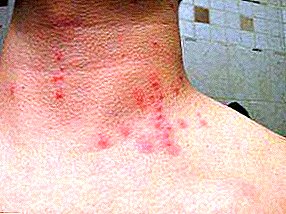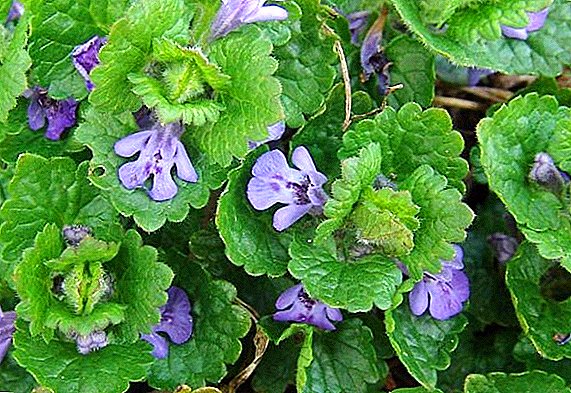
The bug of the soldier or the Cossack, the red-winged wingless one is an insect of the family of the Red-claws. This family has more than a hundred species.
The firebug prefers a warm and humid climate, so it mostly lives in tropical and subtropical latitudes (North Africa, North America). But some of its species have taken root in Russia.
Specifications
Appearance, food, habitat
This bug Considered a harbinger of spring and heat, since it can be seen as one of the first insects appearing on the world after long winter days.
Size of his torso small 7-10 mm. The body is round, slightly flattened. Bug has a characteristic color: red with black ornament on the back. Rear wings missing.
Sometimes there are varieties of soldiers with a yellow color, but with the same unchanging black pattern.
Insect has mouth in the form of piercing-sucking proboscis. Using such a trunk, the bug can pierce them not only with the plant membrane but even with the hard shell of dead insects and suck out the fluid in them. In addition to cell sap bug eats seeds of plants, fruits (most often fallen from a tree), small weeds.
 The soldier lives in small colonies. Abundant accumulation of bedbugs soldiers can be seen near stumps, along a fence or a fallen tree. They prefer to gather in places sunny, open and warm.
The soldier lives in small colonies. Abundant accumulation of bedbugs soldiers can be seen near stumps, along a fence or a fallen tree. They prefer to gather in places sunny, open and warm.
From December to early March, the bugs hibernate. Private places for this they choose in advance. Usually it is dry and warm crevices in trunks, fences, old wooden buildings.
Often bedbugs are confused with a firefighter beetle. But the difference between them is easy to see. These two insect species differ in body shape (it is more oblong in a fireman). Among other things, bugs tend to leave behind an unpleasant smell.
Soldiers belong to the pest and can not fly. The firefighter, on the other hand, protects gardens and vegetable gardens from harmful insects and flies, albeit slowly.
Visually assess how a bug looks like a soldier: photo below





Breeding
They multiply incredibly fast (this should be known to the owners of the dacha plots and, when 1-2 individuals of the soldier bug appear, bring them out immediately in order to avoid mass invasions).
The process of mating of the soldier bugs is original: the male and the female are interconnected by the back of the body, forming a kind of "train" (diesel locomotive with the car), moving in different directions. As a result, the seed cells of the male beetle are moved to the female bug. This is fertilization of eggs.
White colored eggs the soldiers lay in the internal tissue of plants (leaves, cuttings, shoots, trunks) that currently feed. One egg-laying contains from 20 to 30 eggs. Since the type of development in these insects is an incomplete metamorphosis (transformation), the bug does not have a pupa, respectively.
Testicular larvae appear after 1.5 weeks. The larva differs from the adult insect by its smaller size and uniformly red color of the body.
Damage caused by the bug
For a long time, scientists have not ranked the bug of the soldier among the malicious insects. But over time, the behavior of these bugs began to change: they began to actively attack other insects, destroy garden and garden vegetationcreating a lot of trouble and trouble for the owners of gardens and suburban areas.
 Feeding on plant sap, fruits and berries, soldiers are able to destroy emerging shoots of different cultures. Damaged shoots dry up, and the corroded fruits of fruit trees and berry bushes lose their appearance and are no longer suitable for food.
Feeding on plant sap, fruits and berries, soldiers are able to destroy emerging shoots of different cultures. Damaged shoots dry up, and the corroded fruits of fruit trees and berry bushes lose their appearance and are no longer suitable for food.
Breeding very intensively, the army of soldier bugs can cause considerable damage not only to the dachas, but also to farms. Particularly affected by the invasion of these malicious bugs. vineyards, as both stalks and fruits are destroyed.
Methods of struggle
To fight the bugs by the soldiers, certain measures are required, so it is very important to know for sure that these pests are besieging your plot.
There are signs of a lesion characteristic of these malicious insects:
- buds and flowers fall off;
- cabbage leaves are covered with yellow spots, partially die off;
- umbrella plants dry very quickly;
- curled and dried beet tops;
IMPORTANT! Soldiers must be destroyed at the very first appearance on the plot. These insects lay eggs in the stems of plants that will later destroy the young that have appeared.
How to deal with uninvited guests and prevent their further possible appearance?

- garden crops should be interspersed black cohosh. This odorous plant is able to scare away bedbugs. They will leave your country plot forever;
- it is necessary to plant alfalfa and legumes away from fruit crops, as the soldiers spend the winter on these plants and in the beginning of spring they will appear on your site;
- bankol - absolutely harmless to people and animals means disastrously acting on bedbugs. 7-10 mg. the powder is diluted in 10 liters of water and sprayed with all the vegetation;
- is necessary keep the area clean, weed in a timely manner weeds, burn the grass;
- it is desirable to have a strip of clean land between the weeds and the garden, it will also help protect your land from the influx of bedbugs;
- treat the plot with insecticidal agents against the Colorado potato beetle. It should be remembered that insecticides kill not only pests, but also beneficial insects. Chemicals also harm the crop and its environmental friendliness;
- to treat the area with broth onion peel;
Soldier bugs are not the most serious pests that can become an irreparable disaster for dacha plots. It is easy enough to cope with them, it is just necessary to do it in time, without waiting for their mass distribution.












